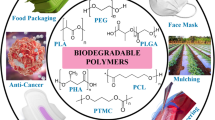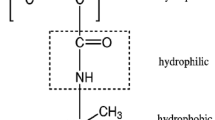Abstract
Novel physically crosslinked polyurethane-hexafluorobutyl methacrylate (PU-M) copolymers were prepared by the macroiniferter-controlled radical polymerization method. The chemical structures of the PU-M copolymers were characterized by FT-IR, 1H-NMR, GPC, DSC, and XPS. The self-assembly and surface properties of the PU-M copolymers have been investigated. The results revealed that PU-M copolymers have good hydrophobility, so the hydrophobility of polyurethane could be easily adjusted by controlling the content of the hydrophobic vinyl monomers. The mechanical evaluation shows that PU-M copolymers exhibit good mechanical properties. The effects of the fluorine content on the surface properties and self-assembly of the PU-M copolymers were investigated. The morphology of the PU-M copolymers’ self-assembly was observed by transmission electron microscopy (TEM) and scanning electron microscopy (SEM), and the mechanism of self-assembly was investigated. Antimicrobial property of the chlorinated PU-M copolymers against both Escherichia coli and Bacillus subtilis bacteria was examined and showed increase compared to that of pure polyurethane.
Graphical Abstract
Novel PU-M copolymers were synthesized by the macroiniferter controlled radical polymerization method. The structure of polymers was characterized by 1H NMR and IR. Solvent-induced assembly of polymers was investigated by dissolving the polymer in THF:water (80:20, v/v), filtering and dropping onto a glass patch. After evaporation for 48 h under ambient conditions, the samples were observed by SEM. The PU-M copolymers were subjected to solvent-induced self-assembly in THF + water to construct variety of morphologies ranging from pores (150–650 nm) to spheres (90 nm to 1.2 μm). A mechanism is proposed according to solvent-induced self-assembly.













Similar content being viewed by others
References
Vara DS, Punshon G, Sales KM, Salacinski HJ. Development of an RNA isolation procedure for the characterisation of human endothelial cell interactions with polyurethane cardiovascular bypass grafts. Biomaterials. 2005;26:3987–93.
Yu XH, Okkema AZ, Cooper SL. Synthesis and physical properties of poly(fluoroalkylether)urethanes. J Appl Polym Sci. 1990;41:1777–95.
Massa TM, Yang ML, Ho JC, Brash JL, Santerre JP. Fibrinogen surface distribution correlates to platelet adhesion pattern on fluorinated surface-modified polyetherurethane. Biomaterials. 2005;26:7367–76.
Tan H, Guo M, Du R, Xie X, Li J. The effect of fluorinated side chain attached on hard segment on the phase separation and surface topography of polyurethanes. Polymer. 2004;45:1647–57.
Robert W, James A, Rick M, Ken S. In vivo biostability of polyether polyurethanes with fluoropolymer and polyethylene oxide surface modifying endgroups; resistance to metal ion oxidation. J Biomed Mater Res Part A. 2007;80:34–44.
Robert W, James A, Rick M, Ken S. In vivo biostability of shore 55D polyether polyurethanes with and without fluoropolymer surface modifying endgroups. J Biomed Mater Res Part A. 2006;79:836–45.
Tonelli C, Ajroldi G, Turturro A, Marigo A. Synthesis methods of fluorinated polyurethanes. Polymer. 2001;42:5589–98.
Huang SL, Chao MS, Ruaan RC, Lai JY. Microphase separated structure and protein adsorption of polyurethanes with butadiene soft segment. Eur Polym J. 2000;36:285–94.
Chen K, Kuo JF. Synthesis and properties of novel fluorinated aliphatic polyurethanes with fluoro chain extenders. Macromol Chem Phys. 2000;201:2676–86.
Wang LF, Wei YH, Chen KY, Lin JC. Properties of phospholipid monolayer deposited on a fluorinated polyurethane. J Biomater Sci Polym Ed. 2004;15:957–69.
Tonelli C, Trombtta T, Scicchitano M, Simeone G, Ajroldi G. New fluorinated thermoplastic elastomers. J Appl Polym Sci. 1996;59:311–27.
Ho T, Wynne KJ. A new fluorinated polyurethane: polymerization, characterization, and mechanical properties. Macromolecules. 1992;25:3521–7.
Takahara A, Jo NJ, Takamori K, Kajiyama T. In progress in biomedical polymers. 2nd ed. New York: Plenum Press; 1990.
Tang YW, Santerre JP, Labow RS, Taylor DG. Use of surface-modifying macromolecules to enhance the biostability of segmented polyurethanes. J Biomed Mater Res. 1997;35:371–81.
Grodzinski J. Preparation of functionalized polymers using living and controlled polymerizations. React Funct Polym. 2001;49:1–54.
Sundar S, Tharanikkarasu K, Dhathathreyan A, Radhakrishnan G. Aqueous dispersions of poly(urethane-co-vinyl-pyridine) synthesised from polyurethane macroiniferter. Colloid Polym Sci. 2002;280:915–21.
Otsu T, Matsumoto A. Controlled synthesis of polymers using the iniferter technique: developments in living radical polymerization. Adv Polym Sci. 1998;136:75–137.
Mahesh GN, Sivaraman A, Tharanikkarasu K, Radhakrishnan G. Synthesis and characterization of polyurethane–polyvinylbenzyl chloride multiblock copolymers and their cationomers using a polyurethane macroiniferter. J Polym Sci A Polym Chem. 1997;35:1237–44.
Baek SH, Kim BS, Kim BK. Hydrogels based on polyurethane–polyacrylic acid multiblock copolymers via macroiniferter technique. Prog Org Coat. 2004;49:353–7.
Saimani S, Tharanikkarasu K, Radhakrishnan G. Aqueous dispersions of polyurethane polyacrylic acid multiblock copolymers through living radical polymerization. J Appl Polym Sci. 2003;87:1109–15.
Tharanikkarasu K, Radhakrishnan G. Tetraphenylethane iniferters: polyurethane-polystyrene multiblock copolymers through “living” radical polymerization. J Appl Polym Sci. 1997;66:1551–60.
Yoon SC, Ratner BD. Surface and bulk structure of segmented poly(ether urethanes) with perfluoro chain extenders. Macromolecules. 1988;21:2392–400.
Tanaka M, Mochiziki A, Ishii N, Motomura T, Hatakeyama T. Study of blood compatibility with poly(2-methoxyethyl acrylate). Biomacromolecules. 2002;3:36–41.
Lin YH, Chou NK, Chang CH, Wang SS, Chu SH, Hsieh KH. Blood compatibility of fluorodiol-containing polyurethanes. J Polym Sci Part A Polym Chem. 2007;45:3231–42.
Karthaus O, Maruyama N, Cieren X, Shimomura M, Hasegawa H. Water-assisted formation of micrometer-size honeycomb patterns of polymers. Langmuir. 2000;16:6071–6.
Wang Y, Liu Z, Huang Y, Han B, Yang G. Micropatterned polymer surfaces induced by nonsolvent. Langmuir. 2006;22:1928–31.
Soo PL, Eisenberg A. Preparation of block copolymer vesicles in solution. J Polym Sci Part B Polym Phys. 2004;42:923–38.
Huang W, Luo C, Zhang J, Yu K, Han Y. Tethered diblock copolymer chains on platelets prepared by semicrystalline abc triblock copolymers in toluene with trace amounts of water. Macromolecules. 2007;40:8022–30.
Acknowledgments
This project was supported by National 863 Foundation of China (No. 2006 AA 02 Z4D4) and the China Postdoctoral Science Foundation (Nos. 20080430033 and 200902090). The Project was Supported by The Tribology Science Fund of State Key Laboratory of Tribology (SKLTKF10B08).
Author information
Authors and Affiliations
Corresponding author
Rights and permissions
About this article
Cite this article
Jiang, G., Tuo, X., Wang, D. et al. Synthesis and properties novel polyurethane-hexafluorobutyl methacrylate copolymers. J Mater Sci: Mater Med 23, 1867–1877 (2012). https://doi.org/10.1007/s10856-012-4670-y
Received:
Accepted:
Published:
Issue Date:
DOI: https://doi.org/10.1007/s10856-012-4670-y




